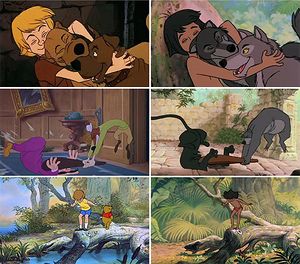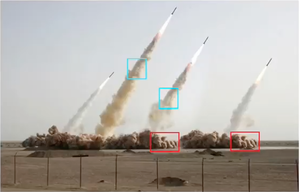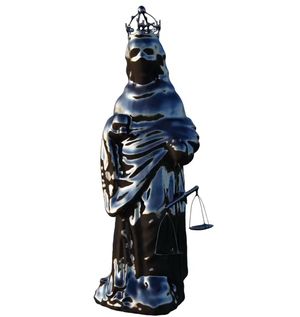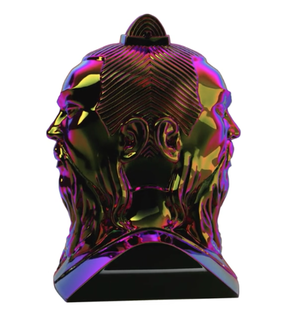Versions

Title Screenshots of Version 2010
Medium Video
Duration 9 minutes
Subject Matter
Versions (2009-2012) is an ongoing video project by Oliver Laric that deals with historical and contemporary ideas relating to image hierarchies. It proposes that present methods of creative production challenge the hierarchy of an authentic ‘original’ image. Rather than privileging a primary object, Versions suggests a re-direction for image making, one in which bootlegs, copies and remixes increasingly usurp ‘originals’ in an age of digital production.[1]
Oliver Laric’s work explores how the copy, the bootleg, and the remix have played a part in both historic and contemporary image cultures. His research involves appropriating objects, images, videos, and sculptures. Laric works in the boundaries between the authentic and the inauthentic, the original and its subsequent reflections and reconfigurations.[2]
Work's Content
He has started this ongoing project in 2009 and now he has three different kinds of Versions: Versions (2009), Version (2010), Version (2012). ‘Versions’ is a documentary-type film on protected authorship and piracy in various fields of creative production. Placed in a historical perspective, this copyright manifesto even goes back to the Classics and the 16th-century iconoclasm. The film brings up numerous examples of reuse, such as, classic literature and its many followers, copies of classic sculptures, cam movies, Photoshopped news photos, and reuse of the same scenes in various animation films. In this way, Laric strives to demonstrate that reuse is nothing new. 'Versions' investigates the peculiarities of original and copy: both have a different status, and the copy is not necessarily inferior to the original. Each version of a work has its own meaning and is a contribution to culture.[3]
Examples from Versions(2009-2012)

Title Iran revolutionary Guard Missile (Screenshot of Version 2009)
Medium Video, Audio
Duration 6.25 minutes

Title Virgin Mary 3D Rendering (Screenshot of Version 2010)
Medium Video, Audio
Duration 9 minutes

Title: Suntzu 3D Rendering (Screenshot of Version 2012)
Medium Video, Audio
duration 6:15 minutes
In Versions (2009) we see the start of the film is the case of the Iranian Revolutionary Guard which used crude Photoshop techniques to give the impression of greater firepower.In 2008, during a period of heightened awareness about provocative Iranian missile testing, an image of a multiple missile launch was released by the Iranian Revolutionary Guard which then the image was revealed to have been Photoshopped - where four missiles were shown, two had obvious identical features in the smoke formation around them. This caused an explosion of manipulated images produced by anonymous web-based authors. [4] "In this manner the simulacrum manufactures itself and proliferates. We are faced with an interplay of signs that refers only to itself rather than a signified content. And this is where the work’s ambiguity really arises. On the one hand this interplay dissolves notions of authorship and originality. On the other, however, it leads us to a position where reality is constituted by the popularity of a search result. As the narrator of Versions put it: ‘The more often an image is viewed, the more likely it makes the top of search results. An image viewed often enough becomes part of collective memory.’ Without any grounding in the real the denial of origin carries with it a lack of temporal integrity and the loss of historicity. We exist in a depthless and perpetual present, where any reality is as (im)possible as any other. Hence, perhaps, the narrator’s mechanical, static, almost unreal, voice." [5]
Version (2010) starts with a discussion of iconoclasm - the degradation of sacred objects, and the way in which these were ‘modified to represent something new.’ During the Protestant Reformation, for instance, a 16th-century sculpture of the Virgin Mary was turned into a personification of Justice by replacing the Christ child with scales. This sculpture was then reinterpreted by Laric when he asked a 3D modeller to reconstruct the Virgin digitally, coating her in ‘terminator-esque’ colours. A similar process occurs in Icon (Utrecht) and Icon (Worcester), where Laric has produced polychromatic versions of vandalised icons in sculptural form. The suggestion in these works is that a certain potentiality inheres in the objects that surround us, a potential for future mutability and change. [6]
The Version (2012) deals with perceptions of value and variability, touching on issues of hybridization within the discourse of post-colonialism .It consists the 3D rendering of portrait of Sun Tzu a Chinese military general, strategist and philosopher and author of The Art of War who lived in ancient China. Inspired by the recent public obsession with Sun Tzu, Laric has cast Sun Tzu’s bust as a two-faced idol reminiscent of Janus, the Roman two-faced god who looks back at the past and into the future, thus hybridizing Eastern and Western cultures.[7]
Sound of the Videos
The latest iteration of Versions, like it’s predecessors, is made up of a collection of discreet, yet thematically related segments that circle around Laric’s perennial concerns related to notions of authenticity, value, and permanence. In keeping with Laric’s interest in the semblance of things, Versions is accompanied by a computerized-sounding narration – a voiceover that is actually the recorded voice of an actress instructed by Laric to mimic the stilted diction of text-to-speech software. In previous iterations, the narration took on a quasi-expository role, whereas here it takes the form of a collage of gnomic declarations culled from high and low sources, in which one finds, for example, a quote from Bruce Lee juxtaposed with a passage from Jorge Luis Borges, or a rhyme lifted from the RZA. All of the quotations have a relevant thematic heft; some referring more directly to the visual piece they accompany than others.[8][9]
Overall Interpretation
These videos act as gathering points for his theoretical, aesthetic, and research concerns with the bootleg, the remix, and the hybrid. Whilst the Versions videos function as kind of compendium of Laric’s evolving interests, they also act as sites where these interests can be further elaborated, played against one another, and allowed to coagulate, if only temporarily, into a whole.
External Links
References
- ↑ http://www.seventeengallery.com/artists/oliver-laric/
- ↑ http://listart.mit.edu/exhibitions/oliver-laric-versions
- ↑ http://thisistomorrow.info/articles/artist-profile-oliver-laric
- ↑ http://openfileblog.blogspot.ca/2012/12/oliver-laric-versions-2009.html
- ↑ http://thisistomorrow.info/articles/artist-profile-oliver-laric
- ↑ http://thisistomorrow.info/articles/artist-profile-oliver-laric
- ↑ http://www.tanyaleighton.com/index.php?pageId=503&l=en
- ↑ http://www.tanyaleighton.com/p/p000461/LARIC_ART_43_BASEL_web.pdf
- ↑ http://artbasel.insideguidance.com/43/catalog/#!producer/288b28e4b3b5d1c4214fd7987517b767
wiki author
- Farnoosh Shahrokhi